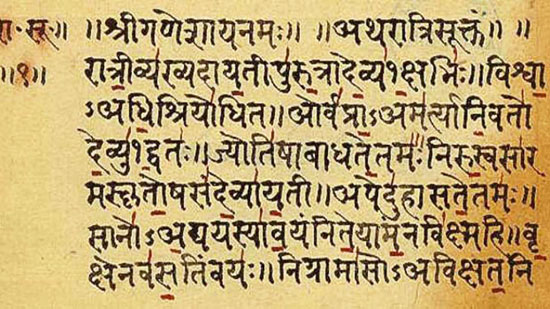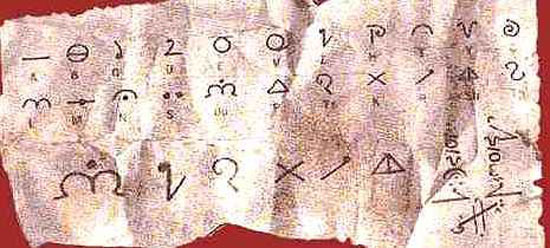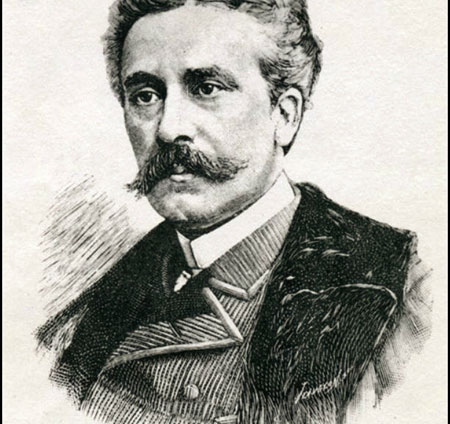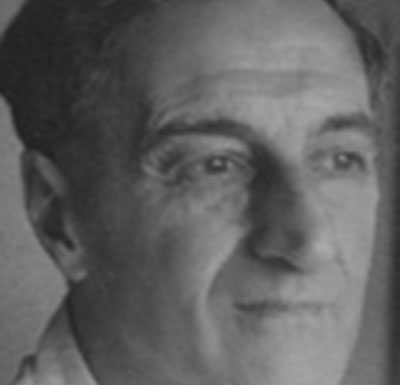Agarttha: Taking the Lid Off the Underground Kingdom
By Alexander Light
In 1884 the French occultist Saint-Yves d’Alveydre
(1842-1909) decided to take lessons in Sanskrit. Having just published his definitive work on
the secret history of the world, called Mission des Juifs (“Mission of the
Jews”), he was anxious to deepen his understanding of the sacred languages which, he
felt sure, concealed the ultimate mysteries.

Hebrew had already revealed much to him; now it was time to
tackle the even more ancient language of Sanskrit, parent of all the Indo-European
tongues.
Saint-Yves’ Sanskrit teacher, who called himself
Hardjji Scharipf, was a character of hazy origins and the subject of various rumours. Born on
December 25, 1838, he supposedly left India after the Mutiny of 1857 and set up in the French
port of Le Havre as a bird-seller and professor of Oriental languages.
His name may have been a pseudonym; he may have been an
Afghan; some called him Prince. But whatever his story, the manuscripts now in the Library of
the Sorbonne in Paris show that Hardjji was a learned and punctilious teacher, and the source of
two still unsolved enigmas: the underground kingdom of Agarttha, and its sacred language.
Three times a week, Hardjji would come to Saint-Yves’
luxurious home with a beautifully scripted lesson of grammar and a reading from some Sanskrit
classic. But his diligent pupil became more and more fascinated by Hardjji’s mysterious
hints, which began when he signed the very first lesson as “Teacher and Professor of
the Great Agartthian School.”
Saint-Yves must have asked him what this “Great
Agartthian School” was. He might already have read in the books of the popular travel
writer and historian Louis Jacolliot of an “Asgartha,” supposedly a great city of
the ancient Indian priest-kings, the Brahmatras. Does such a place still exist, then?
Apparently Hardjji made him to believe so, and, what is more,
that it preserves a language and a script known as “Vattan” or
“Vattanian,” that are the primordial ones of mankind. For someone in quest
of the secret and sacred roots of language, the mention of such things must have been unbearably
exciting.
Curiosity overcame him on Christmas Day, 1885, when he asked
Hardjji to write out his own name in Vattanian characters. The guru obliged, writing it on the
back of the lesson sheet and adding wryly: “Here, according to your ardent desire; but
really you are not yet sufficiently prepared for Vattan. Slowly and surely!”
Later he must have taught Saint-Yves the Vattanian alphabet
and the principles behind its 22 letter-forms, which Saint-Yves would correlate with the Hebrew
alphabet and with the zodiacal and planetary symbols.

By the end of the course of lessons, Agarttha and Vattanian
had evidently become regular topics of conversation, while Saint-Yves’ interests shifted
from Sanskrit to a kind of comparative Hermeticism. With Hardjji’s approval, he created a
splendid manuscript in red and gold ink containing invocations, sigils, many alphabets, designs
and arabesques made from Sanskrit and Vattanian letters; a list of Vedic and Biblical names
encoded in a so-called “Hermetic or Raphaelic Alphabet”; eighty Vedic
symbols representing the development of the cosmos; a passage on the “Hermetic
Significance of the Zodiac” encoded in planet and zodiac signs; correlations of these
signs with the names of angels and with Vattanian, Sanskrit, Hebrew, and Hermetic characters;
breathing exercises for the hearing of the inner sound “M” and for soul-travel;
notes on the properties of medicinal plants; alchemical recipes.
Saint-Yves Writes a Book About
Agarttha
And this was not all. Did Hardjji know that Saint-Yves was
writing another book – The Kingdom of Agarttha: A Journey into the Hollow Earth
– under the influence of his Oriental studies? It seems doubtful, but in 1886 the book was
finished, typeset, and printed by his regular publisher (Calmann Lévy).
To put it bluntly, this book takes the lid off Agarttha. The
reader will learn that it is a hidden land somewhere in the East, beneath the surface of the
Earth, where a population of millions is ruled by a Sovereign Pontiff, the
“Brahatmah,” and his two colleagues the “Mahatma” and the
“Mahanga.”
This realm, Saint-Yves explains, was transferred underground
and concealed from the surface-dwellers at the start of the Kali Yuga (the present dark age in
the Hindu system of chronology), which he dates to about 3,200 BC. Agarttha has long enjoyed the
benefits of a technology advanced far beyond our own, including gas lighting, railways, and air
travel.
Its government is the ideal one of “Synarchy,”
which the surface races have lost ever since the schism that broke the Universal Empire in the
fourth millennium BC, and which Moses, Jesus, and Saint-Yves strove to restore. (This was the
theme of Mission des Juifs.)
Now and then Agarttha sends emissaries to the upper world, of
which it has a perfect knowledge. Not only the latest discoveries of modern man, but the whole
wisdom of the ages is enshrined in its libraries, engraved on stone in Vattanian
characters.
Among its secrets are those of the true relationship of body
to soul, and the means to keep departed souls in communication with the living. When our world
adopts Synarchical government, the time will be ripe for Agarttha to reveal itself, to our great
spiritual and practical advantage.
In order to speed this process, Saint-Yves includes in the
book open letters to Queen Victoria, Emperor Alexander III of Russia, and Pope Leo III, inviting
them to join in the great project.
Perhaps the oddest thing about this book is Saint-Yves’
own stance. Far from presenting himself as an authorised spokesman for Agarttha, he admits that
he is a spy.
Dedicating the book to the Sovereign Pontiff and signing it
with his own name in Vattanian characters (just as Hardjji had written it out for him), he
expatiates on how astounded this august dignitary will be to read the work, wondering how human
eyes could have penetrated the innermost sanctuaries of his realm.
Saint-Yves explains that he is a “spontaneous
initiate,” bound by no oath of secrecy, and that once the Brahatmah gets over the
shock, he will admit the wisdom of what Saint-Yves has dared to reveal.
How did Saint-Yves obtain this information? Already in his
first book, Clefs de l’Orient (1877), he was writing with the confidence of an
eyewitness of the psychic phenomena accompanying birth, death, and the relation between the
sexes.
In the present work he seems to have extended his psychic
vision, to say the least, and one can glean from here and there an idea of his methods.
There is, for instance, a passage here describing in detail
how the Agartthian initiates travel with their souls while their bodies sleep. Then there is the
passage in the notebook already mentioned, on yogic exercises for separating the soul from the
body. Thirdly, there is a snippet of occult gossip in a conversation with Saint-Yves recorded on
August 16, 1896, by a psychical researcher, Alfred Erny: “He has talked to Papus and
[Stanislas de] Guaïta, but did not tell them what they wanted to know: the method of
disengaging and re-engaging oneself in the astral body. It is dangerous: ‘I don’t
want (he said) to put a loaded revolver into your hands which you don’t know how to
use.’
‘A magnetiser’, he said, ‘runs less
danger than others in duplicating himself, because he is more trained.’
‘When one goes out of one’s body into the
Astral, another evil spirit may replace you’.”
Saint-Yves presumably possessed the secret of this
“somnambulistic” faculty, and used it to gather the information he presents in this
book. But did he gather it, as he claims, from spying on a physical Agarttha beneath the surface
of the Earth? Or was it the result of his own projected fantasies or hallucinations?
Or, again, did it come from some non-physical location or
state which can be accessed under certain conditions, but which then merely supports the
psyche’s own subjective expectations and prejudices? We will return to these questions at
the end.
No sooner was the book printed and ready for the bookshops
than Saint-Yves withdrew it, destroying every copy but one. The work narrowly escaped oblivion,
but this one copy passed after Saint-Yves’ death to Papus, who published it in 1910, with
some omissions, under the auspices of a group of disciples, the “Friends of Saint-
Yves.”
Decades later, it turned out that the printer, Lahure, had
secreted another copy. The late Jean Saunier, biographer and chief authority on Saint-Yves, used
this as the basis for the complete French edition of 1981, now translated into English.
Whatever reasons and motives were responsible for the sudden
withdrawal of the book, there is no doubt that Saint-Yves remained true to his vision. For
instance, he mentions Agarttha and names its three rulers in his epic poem of 1890, Jeanne
d’Arc victorieuse.

Saint-Yves d’Alveydre
In his conversations with Erny in 1896, he stated outright
that there exists a secret “Superior University” with a “High
Priest” who is currently an Ethiopian, and other details just as they appear in this
book. Finally, he mentions Agarttha in veiled terms in L’Archéomètre, the major
work of his last years.
Ossendowski Revives
“Agharti”
After the trauma of World War I, the very name of Agarttha
might have been forgotten, as Saint-Yves himself was. But in 1922, a Polish
“scientist” named Ferdinand Ossendowski (1876-1945) published a sensational travel
and adventure book.
It told of his flight through Central Asia in the aftermath
of the Russian Revolution. While in Mongolia, he heard tell of a subterranean realm of
800,000,000 inhabitants called “Agharti”; of its triple spiritual authority
“Brahytma, the King of the World,” “Mahytma,” and
“Mahynga,” of its sacred language, “Vattanan,” and
many other things that corroborate Saint-Yves.
The book ended on a dramatic note of prophecy from one of
Ossendowski’s informants: that in the year 2029, the people of “Aghardi” will
issue forth from their caverns and appear on the surface of the Earth.
The prophecy was attributed to the King of the World when he
appeared before the lamas in 1890. The King had then predicted that there would be 50 years of
strife and misery, 71 years of happiness under three great kingdoms, then an 18-year war, before
the appearance of the Agarthians.
An unprejudiced reader, finding in three chapters of
Ossendowski’s book a virtual outline of Saint-Yves’ Agarttha, not omitting the most
improbable details, would conclude that the author had capped an already good story with a
convenient piece of plagiarism, altering the spellings so as to make his version, if challenged,
seem informed from an independent source.
At first Ossendowski denied this indignantly. When he was
introduced to the esotericist René Guénon (1886-1951), he said that if it were not for
the evidence of the daily journal he had kept, and of certain objects he had brought back, he
would have thought that he had dreamed parts of this story, adding: “I’d much
prefer that!”
Back in 1908, the young Guénon had taken part in
automatic writing séances in which Agartthian matters had come up, though whether through
the questioners or the channelled entity is now unclear.
Now his interest was rekindled, and in 1925 he wrote about
the striking parallels between Saint-Yves’ Agarttha and the Agharti of Ossendowki, whose
sincerity, according to Guénon, there was no reason to doubt.
Two years later, Guénon took the matter into his own
hands. In his most controversial book, Le Roi du Monde, he announced:
“Independently of the evidence offered by Ossendowski, we know from other sources that
stories of this kind are widely current in Mongolia and throughout Central Asia, and we can add
that there is something similar in the traditions of most peoples.”
Unfortunately Guénon does not support his claim to
privileged access by telling us what these sources are, nor what degree of similitude is meant
by “stories of this kind.”
Near the end of Le Roi du Monde, Guénon faces the
question of whether Agarttha really exists: “Should its setting in a definite location
now imply that this is literally so, or is it only a symbol, or is it both at the same time? The
simple answer is that both geographical and historical facts possess a symbolic validity that in
no way detracts from their being facts, but that actually, beyond the obvious reality, gives
them a higher significance.”
So Guénon at the very least did not deny a geographical
Agarttha. To his way of thinking, if one were found to exist beneath the surface of the Earth,
it would only corroborate the superior reality of the symbolic one.
Ossendowski’s account was later investigated by Marco
Pallis (1895-1985), the traveller, writer on Buddhism, and translator of Guénon, with the
advantage of his own contacts with highly-placed Indians, Tibetans, and Mongolians. One of the
latter, now very old, had been the head lama of a monastery at the time of Ossendowski’s
visit there.

Marco Pallis
He testified that the latter’s stories of the King of
the World and of Agarttha bore no relation to any authentic legend or doctrine whatsoever, and
that Ossendowski’s command of the Mongolian language had not been nearly sufficient to
understand what he claimed to have heard.
Pallis’s Hindu friends, similarly, disclaimed any
Sanskrit source for Agarttha. The inevitable conclusion was that the credulous Guénon had
been misled by Saint-Yves’ fantasy, and that promoting belief in Agarttha in Le Roi du
Monde had been a foolish mistake.
Ossendowski himself had back-pedalled in November 1924 when
pressed to appear before a group of prominent intellectuals and scholars. He confessed to this
hard-boiled audience that Beasts, men and gods was not
“scientific” but “exclusively a literary work,” and
stated the same in a letter to the Royal Geographical Society.
Never mind: once his best-seller had brought the Agarttha
myth out of the esoteric closet, it began to enjoy a new lease on life.
Often confused or contrasted with Shambala, the spiritual
city of Tibetan Buddhism, it became a recurrent theme of popular occult writers.
If we set aside Saint-Yves and Ossendowski, for reasons
already explained, there remain only two independent witnesses to an Indian Agarttha tradition.
Louis Jacolliot was led to place it in the past, as the ancient Brahmanic capital. For Hardjji
Scharipf it was a living initiatic school with its own secret script.
Until a reputable scholar comes forward with data on the myth
of Agarttha, and especially on the Vattanian alphabet, my working hypothesis is that these were
part of a mythology belonging to a restricted and obscure Indian school, which has only surfaced
to Western notice on these two occasions.
However, Saint-Yves wanted more than the tantalising taste
that his Sanskrit teacher allowed him. He therefore decided to use his gift for astral travel to
explore Agarttha further, and was rewarded by visions of an underground utopia and its Sovereign
Pontiff, the spiritual Lord of the World. What is the source, and the ontological status, of
such visions?
The Astral World and Delusions of
Grandeur

There are, one gathers, definite places or complexes in the
Astral World, which present to the clairvoyant visitor certain invariable features. But the
incidental circumstances of such a place vary, according to the visitor’s own cultural
conditioning and expectations.
Some find themselves, for example, in what they believe to be
the Alexandrian Library, or in Atlantis, i.e., a place of the past. To others, it seems current
and contemporary, though preferably in an inaccessible location like the Himalayas.
The décor is a trivial matter, of course, in comparison
to the philosophical truths to be discovered there, but the glamour of it sometimes overwhelms
the traveller. Then his attention fixates on irrelevant details, and an inflated sense of self-
importance may result.
Thus Saint-Yves, convinced that he has penetrated to the
realm of the world’s spiritual ruler, writes about four-eyed tortoises, two-tongued men,
levitating yogis, and ends up addressing pompous letters to Queen, Emperor, and Pope.
I can accept that in some state of altered consciousness he
saw what he claims to have seen. But like many who habitually indulge in altered states, he was
not able to situate his visions, nor himself as witness to them, with the requisite
philosophical detachment. The result is a classic case of the occupational hazard of occultists:
misplaced concretism.
Yet there is a grandeur to this book. Its vivid and elegant
prose lift it far above the tedious wordiness of visionary and channelled writing.
In sheer weirdness of imagination it rivals the fantasy
fiction of H.P. Lovecraft or Jorge Luis Borges, while in deadpan seriousness and titanic self-
confidence it compares to prophetic works like the Book of Ezekiel or the various
Apocalypses. And it reminds us that the Earth is a very complex place, with many unexplored
corners, many enigmas, and many surprises in store for us surface-dwellers.
yogaesoteric
January 16, 2020
